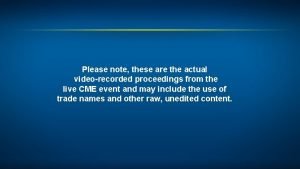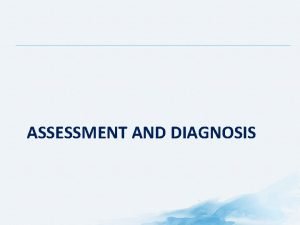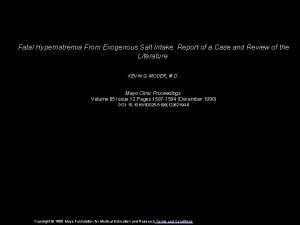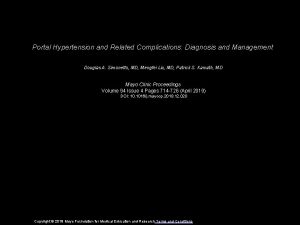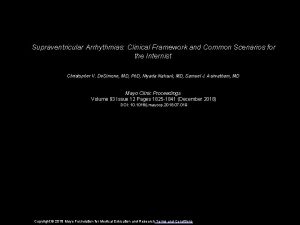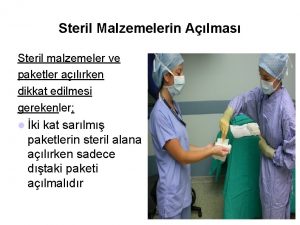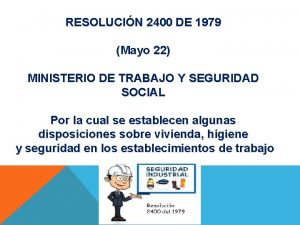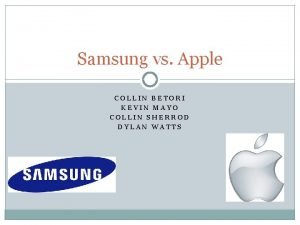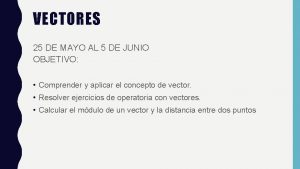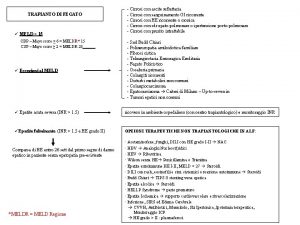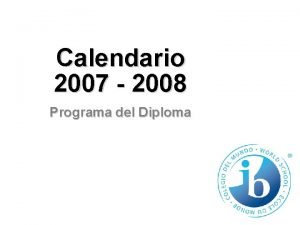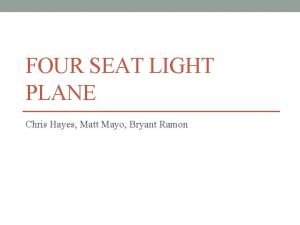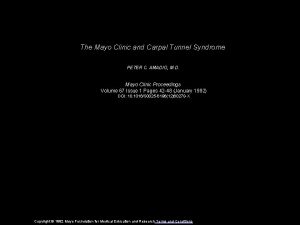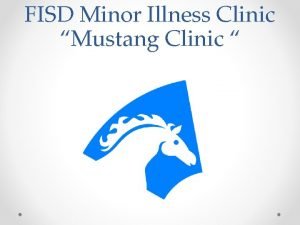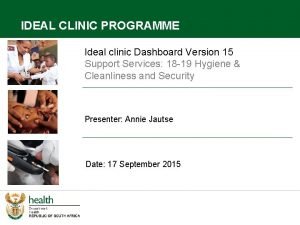Welcome to Mayo Clinic 2012 MFMER 3190128 1

























































- Slides: 57

Welcome to Mayo Clinic © 2012 MFMER | 3190128 -1

Our Primary Value The needs of the patient come first. New Employee Orientation © 2012 MFMER | 3190128 -2

Our Mission To inspire hope and contribute to health and well-being by providing the best care to every patient through integrated clinical practice, education and research. New Employee Orientation © 2012 MFMER | 3190128 -3

Our Vision Mayo Clinic will provide an unparalleled experience as the most trusted partner for health care. New Employee Orientation © 2012 MFMER | 3190128 -4

Pop Quiz What is Mayo Clinic’s Primary Value? The needs of the patient come first. New Employee Orientation © 2012 MFMER | 3190128 -5

Diversity and Inclusion Mutual respect is one of our values. It is important to create an inclusive environment by treating everyone in our diverse community with respect and dignity. © 2012 MFMER | 3190128 -6

Privacy & Your Role in Protecting Patient Information Mayo Clinic Orientation Revised 11/16/2016 © 2013 MFMER | slide-8

Where To Find Us © 2013 MFMER | slide-9

What is Patient Privacy? • Respect for our patients and the information they entrust to Mayo Clinic in order to care for them and to support our business. • Health Insurance Portability and Accountability Act • The Department of Health and Human Services issued HIPAA privacy standards and security standards that require health care entities to protect patient information from unauthorized use or disclosure. HIPAA regulations apply to all Mayo Clinic entities including: Rochester, Arizona, Jacksonville, Mayo Clinic Health System © 2013 MFMER | slide-10

What does Patient Privacy mean to YOU? • Our patients trust us to protect their privacy and keep their information confidential. • By law, all Mayo Clinic employees, students, and contractors must keep protected health information private. • No matter what your role with Mayo Clinic, you will likely encounter Protected Health Information. © 2013 MFMER | slide-11

What is Protected Health Information (PHI)? • HIPAA standards apply to all protected health information (PHI) which includes demographic information and any identifying information about the patient including but not limited to: • • • Name Address Dates related to the patient (e. g. , birth date, appointment dates) Telephone numbers and email addresses Identifying numbers that are specific to the patient, such as Social Security number or medical record number • Pictures of the patient All patient information and demographic information is protected, whether it is on a computer, in a paper record, or verbal. © 2013 MFMER | slide-12

Patients have the right to: • Access their medical information. • Request amendments (changes) to their medical information. • Obtain a list of when and why their medical information was shared externally. • Identified as Accounting of Disclosures request. • Request to have their patient status remain confidential by opting out of the of Patient Directory. © 2013 MFMER | slide-13

Patients also have the right to: • Request restrictions from third-party access to their medical information. • Request alternate communications. • How we communicate their information, including allowing others to receive their information. • Release their information to others. • File a complaint. © 2013 MFMER | slide-14

Permitted Use & Disclosure of PHI • For Treatment Purposes • To provide, coordinate or manage their care. • Includes communication between health care providers and other members of the medical team, both within and outside of Mayo Clinic. • For Payment Purposes • Use and disclose of PHI to create bills and collect payment from insurance companies. © 2013 MFMER | slide-15

Permitted Use & Disclosure of PHI • For Healthcare Operations • Use and disclosure of PHI when necessary to improve the quality of care provided to patients. • Includes activities to improve patient care such as: • license staff to care for patients • prepare for state and federal regulatory reviews • train health care and non health care professionals • manage health care operations • improve health care services You need written patient authorization to use patient information for purposes other than treatment, payment or healthcare operations. Check with your supervisor or Privacy Officer. © 2013 MFMER | slide-16

Permitted Use & Disclosure of PHI • The need-to-know rule is HIPAA’s minimum necessary standard. • Minimum necessary means the least amount of information you need to do your job function. • If your job functions require access to PHI, remember to request, share and disclose only the minimum amount necessary to complete the task. “Curiosity viewing” of patient records is absolutely prohibited. © 2013 MFMER | slide-17

Did you catch that? ! • You must have a treatment or business need-toknow to access a patient’s information. • If you do not have a business need-to-know: • You MUST have a valid patient authorization on file in order to access the patient’s record for personal reasons. • Mayo Clinic Policy prohibits access to your minor child’s record using the Electronic Health Record (EHR). • Do you have written permission or will the access benefit the patient or Mayo Clinic? If the answer is no, the access is personal curiosity and is strictly prohibited by law. © 2013 MFMER | slide-18

Pop Quiz Access to a patient’s medical record is authorized in which of the following scenarios: 1. Your parent was seen by a provider today; you review provider’s instructions regarding medications in the medical record to be sure your parent understands them correctly. 2. Your hip replacement patient is experiencing shortness of breath. Although you are in Orthopedics, you review previous cardiac consultation notes. 3. A patient was seen by your preceptor for an ankle fracture. You are curious about a scar on the patient’s neck. 4. Your sister asks you to check her son’s medical record to verify whether or not a prescription has been called in for his ear infection. © 2013 MFMER | slide-19

If you answered #2, you are correct. There is a business need-to-know in this scenario, in order to provide optimal patient care. Your hip replacement patient is experiencing shortness of breath. Although you are in Orthopedics, you review previous cardiac consultation notes. In all other scenarios, you would need to have a valid patient authorization on file in order to access the patient’s record for the purposes indicated. © 2013 MFMER | slide-20

Breach Reporting • A Breach occurs when PHI is accessed (viewed) or disclosed (shared) without a business need-to-know. • Staff are required to report a discovered or suspected breach to the Privacy Office. • Contact your site/regional Privacy Officer • Report anonymously by calling 1 -888 -721 -5391 or online at www. mayocliniccompliancereport. com • Mayo Clinic strictly enforces the Anti-Retaliation Policy • Staff who knowingly violate Mayo Clinic privacy policies will receive appropriate corrective action, up to and including termination of employment. © 2013 MFMER | slide-21

Basic Security Requirements • Protect yourself and protect our patients • Lock up or keep out of sight any confidential information to ensure that unauthorized people do not see it. • Always remember to lock your workstation or log off when you leave your work area and do not share your username and password. • Any activity under your username is your responsibility! © 2013 MFMER | slide-22

Confidentiality Simply by being on the Mayo campus, you may encounter confidential information concerning patients, employees and business information. Confidential information includes all material (oral, paper-based and electronic) related to the operation of Mayo including but not limited to: • • Financial information Patient names and other identifying information Patient personal and medical information Patient billing information Employee names including salaries and employment information Proprietary products and product development Marketing and general business strategies Any discoveries, inventions, ideas, methods, or programs that have not be publicly disclosed • Any information marked as “confidential” Unauthorized access, use or release of confidential information may be cause for immediate dismissal. © 2013 MFMER | slide-23

Conclusion – Key Points • Do not access or disclose patient information to anyone unless there is a need-to-know. • Social media use should not include any identifiable (or potentially identifiable) patient information. • Discuss patient information in a private place where others cannot overhear. If you overhear other staff discussing patient information, respectfully bring it to their attention. • Keep patient information out of public areas. Do not leave paper containing patient information where others can see it. Dispose of PHI properly. © 2013 MFMER | slide-24

Resources for You • Your department leadership • Site Compliance and Privacy Officers • We are here to help! • Compliance website with contacts and FAQs • Compliance Hotline • Anonymous and confidential • Staffed by external third party • 1 -888 -721 -5391 • www. mayocliniccompliancereport. com © 2013 MFMER | slide-25

Pop Quiz: Which of the following might breach patient confidentiality and be potential cause for dismissal? 1. Taking a selfie on your work unit and posting to Twitter 2. Discussing patient care while on an employee elevator 3. Doing a quick check of your brother’s x-rays to see if you identify a broken bone 4. Sending an email to your school adviser regarding the unique case you saw this afternoon © 2013 MFMER | slide-26

All scenarios may be a breach: 1. If a patient is in the background, this is potential breach. 2. Although an employee elevator may seem like a safe place to discuss patient care, a relative or friend of the patient may be on the elevator. 3. Unless you have a valid authorization from your brother on file, you may not access any part of his medical record – even if he verbally requests it. 4. If any information is disclosed by which someone might identify the patient, a breach has occurred. Of note, patient information should never be sent via email unless encrypted. © 2013 MFMER | slide-27

Information Security Social Engineering Attacks It’s imperative to handle Mayo Clinic’s information technology tools in a responsible and inquiring manner. Beware of potential information security attacks such as those described in subsequent slides. © 2012 MFMER | 3190128 -28

Phishing • Phishing § Email phishing is the #1 way criminals obtain info. Always click the phishing icon in the upper right hand corner of Outlook to report suspicious emails § Ex) Email informs you that your password has expired, it requests you to click on an outside link to renew it New Employee Orientation © 2012 MFMER | 3190128 -29

Baiting and Social Identity • Baiting § Ex) A link pops up naming you the 100 th person to visit the site; you win an award by clicking the link below! • Social Identity § Ex) Criminal obtains your DOB from your social media account New Employee Orientation © 2012 MFMER | 3190128 -30

Vishing and Tailgating • Vishing § Ex) You receive a phone call saying they are Mayo Clinic and your account has been hacked. They need your password to reset your account. • Tailgating § Ex) A person without a badge asks you to hold the door to a secure location for them. New Employee Orientation © 2012 MFMER | 3190128 -31

Infection Prevention and Control Everyone’s Responsibility © 2012 MFMER | 3187658 -32

What You Need to Know • Learn to readily identify invisible, small causes of disease, so that you can protect yourself, our patients, visitors, and your coworkers from the risk of an infection • Describe how diseases are spread by the Chain of Infection • Identify your role in preventing the spread of disease in the work place New Employee Orientation © 2012 MFMER | 3187658 -33

The Chain of Infection Infectious Agent Susceptible Host Reservoir Portal of Exit Portal of Entry Mode of Transmission New Employee Orientation © 2012 MFMER | 3187658 -34

Primary Prevention – Stay Home When Sick • Fever • Persistent cough • Diarrhea • Vomiting New Employee Orientation © 2012 MFMER | 3187658 -35

Primary Prevention – Stop Transmission at Work • Hand hygiene • Respiratory etiquette • Disinfect your work area • Stay current on immunizations • Stay informed New Employee Orientation © 2012 MFMER | 3187658 -36

Your Role – Hand Hygiene • Soap and water § Before eating § After using the restroom § When hands are visibly soiled • Waterless alcoholbased hand rub Note: Artificial nails are not permitted when working directly with or handling patient food/medication. New Employee Orientation © 2012 MFMER | 3187658 -37

Your Role – Follow Respiratory Etiquette • Cover your cough or sneeze • Use simple masks for patients or yourself • Perform hand hygiene New Employee Orientation © 2012 MFMER | 3187658 -38

Your Role – Get Your Immunizations break the chain of infection by protecting you from becoming the next host and spreading disease. U. R. Sick At risk of illness Vaccinated New Employee Orientation © 2012 MFMER | 3187658 -39

If An Exposure Occurs…… • Wash area immediately with soap and water • If exposure to mouth or eyes, flush with large amounts of water • Seek evaluation immediately by calling Employee Health or your Supervisor • Do not wait until the next work day to report NOTE: Search “Pathogen” on Mayo intranet to find Exposure Control Plan specific to your assigned location. New Employee Orientation © 2012 MFMER | 3187658 -40

Pop Quiz Complete the following statements: Proper hand hygiene requires use of soap and water before …. … eating, after using the restroom, or when hands are visibly soiled. Immunizations break the chain of infection by protecting you from becoming the next host and …… spreading disease. Respiratory etiquette includes covering your cough or sneeze, performing proper hand hygiene, and ……. using simple masks for patients or yourself. New Employee Orientation © 2012 MFMER | 3187658 -41

Mayo Clinic Safety Enterprise Physical Security Department © 2012 MFMER | 3190128 -42

Fire (Code Red): RACE and PASS RACE • Rescue /Relocate (Move yourself and others out of harm’s way), Alert /Alarm (call 911), Confine, Extinguish PASS • Pull (the pin) • Aim (at the base of fire); • Squeeze (the handles together) • Sweep the extinguisher side to extinguish New Employee Orientation © 2012 MFMER | 3190128 -43

Fire Safety Guidelines • Locate fire extinguishers and pull stations in your area • Ask your supervisor about department and site specific plans • Know your fire exit signs • Know your evacuation routes, for both fire and other emergencies. Move to safety. • Prioritize your safety and the safety of your patient, visitors, and colleagues over all other concerns New Employee Orientation © 2012 MFMER | 3190128 -44

Succeeding at Mayo Clinic © 2012 MFMER | 3190128 -45

Mutual Respect • Foster mutual respect and support Mayo’s commitment to diversity § Mutual Respect policy § Harassment policy § Title IX Sexual Misconduct policy Everyone has the right to pursue his/her career free from harassment, coercion or disruptive conduct from coworkers or organizational superiors. New Employee Orientation © 2012 MFMER | 3190128 -46

Sexual and Other Harassment An unwelcome behavior or action of a sexual nature is sexual harassment when • Made a term or condition of employment affecting an individual • Used as the basis for employment decisions affecting the individual • Interferes with one’s work performance or creates an intimidating, hostile, or offensive work environment Third party harassment can create a hostile work environment. • May not bother the two people involved in a conversation, but bothers a third party. New Employee Orientation © 2012 MFMER | 3190128 -47

Social Media Guidelines Visit the Mayo Clinic Social Media Network page via the intranet § Do not share confidential or proprietary information about Mayo Clinic. § Must maintain patient privacy. § Applies whether posting to own sites or commenting on other sites. § Photographs containing any patient identifiable information are strictly prohibited. New Employee Orientation © 2012 MFMER | 3190128 -48

Pop Quiz True or False: § I may send a patient a “friend” request. § Photos are okay so long as the patient consents to taking the picture. § You just assisted on a really interesting procedure; it’s okay to post about it! New Employee Orientation © 2012 MFMER | 3190128 -49

FALSE • All of the answers to the pop quiz are false as they violate patient rights concurrent with HIPAA. Please review the Social Media Network guidelines for further information. New Employee Orientation © 2012 MFMER | 3190128 -50

Dress Code © 2012 MFMER | 3190128 -51

Accessories – conservative in nature Not Appropriate (Red) Dress & Decorum Appropriate (Green) New Employee Orientation © 2012 MFMER | 3190128 -52

Footwear Open toe, open heel shoes must include a strap Casual sandals, stilettos, platform shoes, and hiking boots are not appropriate Dress & Decorum New Employee Orientation © 2012 MFMER | 3190128 -53

Clinical Attire Scrub color based on clinical area and role. Shirts worn under scrubs must be white or color similar to scrubs. Dress & Decorum New Employee Orientation © 2012 MFMER | 3190128 -54

Appropriate Casual and Business Attire Dress & Decorum New Employee Orientation © 2012 MFMER | 3190128 -55

Inappropriate Attire Dress & Decorum New Employee Orientation © 2012 MFMER | 3190128 -56

Identification badge must be worn above waist level. Dress & Decorum New Employee Orientation © 2012 MFMER | 3190128 -57

Congratulations! You have completed the Mayo Clinic Health System student orientation module. Department-specific orientation will be provided on-site by your Mayo Clinic supervisor/preceptor. IMPORTANT: Click icon below to download your Completion Certificate. After printing and signing this document, give it to your instructor/advisor to keep in your student file at your academic institution. New Employee Orientation © 2012 MFMER | 3190128 -58
 Mayo clinic multiple myeloma
Mayo clinic multiple myeloma Meld score mayo
Meld score mayo Visceral hyperalgesia mayo clinic
Visceral hyperalgesia mayo clinic Mayo clinic dress code
Mayo clinic dress code Protandim reviews mayo clinic
Protandim reviews mayo clinic Hypernatremia mayo clinic
Hypernatremia mayo clinic Pericarditis
Pericarditis Elliott richelson
Elliott richelson Mayo clinic
Mayo clinic Portal hypertension mayo clinic
Portal hypertension mayo clinic Mayo clinic
Mayo clinic Fredric b. meyer
Fredric b. meyer Wise men three clever are we
Wise men three clever are we Babcock tissue forceps uses
Babcock tissue forceps uses Conor mayo-wilson
Conor mayo-wilson Poesia a mi madre querida
Poesia a mi madre querida Feliz jueves 6 de mayo
Feliz jueves 6 de mayo Salitang espanyol ng sarsuwela
Salitang espanyol ng sarsuwela Tercer hito
Tercer hito Proktosigmoiditis ulcerosa
Proktosigmoiditis ulcerosa Mayonnaise emulsifier
Mayonnaise emulsifier Mayo's vest over pants operation
Mayo's vest over pants operation Behavioral management theory
Behavioral management theory Vedalizumab
Vedalizumab What is the biggest misconception about cinco de mayo
What is the biggest misconception about cinco de mayo Morrow mayo aimee rises from the sea
Morrow mayo aimee rises from the sea Collage del 25 de mayo
Collage del 25 de mayo Social motivaiton
Social motivaiton Mayo masası hazırlığı
Mayo masası hazırlığı Resolución 2400 de mayo 22 de 1979
Resolución 2400 de mayo 22 de 1979 Mindy mayo
Mindy mayo Usaha pisang coklat kulit lumpia
Usaha pisang coklat kulit lumpia Tres de mayo analyse
Tres de mayo analyse Kevin mayo
Kevin mayo Feliz jueves 13 de mayo
Feliz jueves 13 de mayo Mes de mayo mariano
Mes de mayo mariano 25 de mayo vector
25 de mayo vector Rizal in london
Rizal in london Meld mayo
Meld mayo A escola das relações humanas
A escola das relações humanas Iftikhar ahmed md
Iftikhar ahmed md Eleventho de mayo
Eleventho de mayo Calendario mayo 2007
Calendario mayo 2007 Efemérides literarias de enero
Efemérides literarias de enero Fiesta 24 de mayo
Fiesta 24 de mayo Elton mayo theory of motivation
Elton mayo theory of motivation Fiesta 17 de mayo
Fiesta 17 de mayo Mayo recovery college
Mayo recovery college Ketchupi amora
Ketchupi amora Matt mayo
Matt mayo Https://mayoweb.mayo.edu/
Https://mayoweb.mayo.edu/ Causas de la revolución de mayo
Causas de la revolución de mayo Mayo 5 1888
Mayo 5 1888 Teoria di mayo
Teoria di mayo Proposal usaha risoles
Proposal usaha risoles Dr peter amadio
Dr peter amadio Dr silkworth
Dr silkworth Isabel mayo
Isabel mayo
